Is your floor showing signs of wear? You’re not alone. Over time, floors experience constant pressure from foot traffic, furniture, spills, and environmental factors, leading to visible damage.
The good news is that most floor damage can be repaired, and with the right techniques, you can bring your floors back to life without needing to hire an expert.
In this guide, we’ll cover the most common types of floor damage, how to fix them, and when it’s time to call in the professionals.
Let’s look into how you can restore the beauty and functionality of your floors.
What Causes Floor Damage?
Understanding why floors become damaged helps you prevent future problems. Most floors experience damage from daily use, with furniture legs scratching surfaces as they move.
Heavy items like refrigerators or bookcases can create dents or cracks when placed directly on flooring materials.
Water is one of the biggest threats, from leaking pipes, spills, or high humidity, causing materials to expand, contract, or grow mold.
Homes with pets and children face extra challenges from running, dropped toys, and accidents.
Finally, floors installed incorrectly or made with low-quality materials tend to show signs of damage much sooner, regardless of how carefully you treat them.
Signs You Need A Floor Damage Repair
Cracks, chips, and dents – These visible surface problems indicate physical damage to your flooring that requires attention. Small issues can worsen if left untreated.
Uneven flooring – When your floor has high or low spots that you can feel when walking, this suggests potential structural problems underneath that need fixing.
Bending or rising edges – Floors that no longer lie flat, with edges or centers that rise up, often point to moisture issues that have caused the materials to swell.
Color changes or stains – Areas that have darkened, faded, or won’t come clean with regular methods may need deep cleaning or replacement.
Sounds when walking – Creaks, squeaks, or hollow noises suggest that your flooring has come loose from the subfloor and should be secured properly.
7 Common Types of Floor Damage and How to Fix Them
Your floors endure daily wear from traffic, furniture, and everyday activity. Learning to spot and fix common damage can save money while keeping your home looking great without professional help for minor repairs.
1. Scratches and Scuffs

Surface marks are common on most flooring types and occur due to daily use, moving furniture, or pet nails.
While minor scratches might seem small, they can collect dirt and worsen over time, making your floors look worn and old before their time.
How to Fix:
- For hardwood: Clean the area, then use a color-matching wood marker or crayon to fill in the scratch
- For deeper scratches: Apply wood filler with a putty knife, let dry, sand smooth, then stain to match
- For laminate: Use a repair kit with fill material that matches your floor color
- For vinyl: Apply specialized repair compound that bonds with the existing floor material
- After repair: Protect the area with floor wax or polish appropriate for your floor type
2. Cracks and Chips
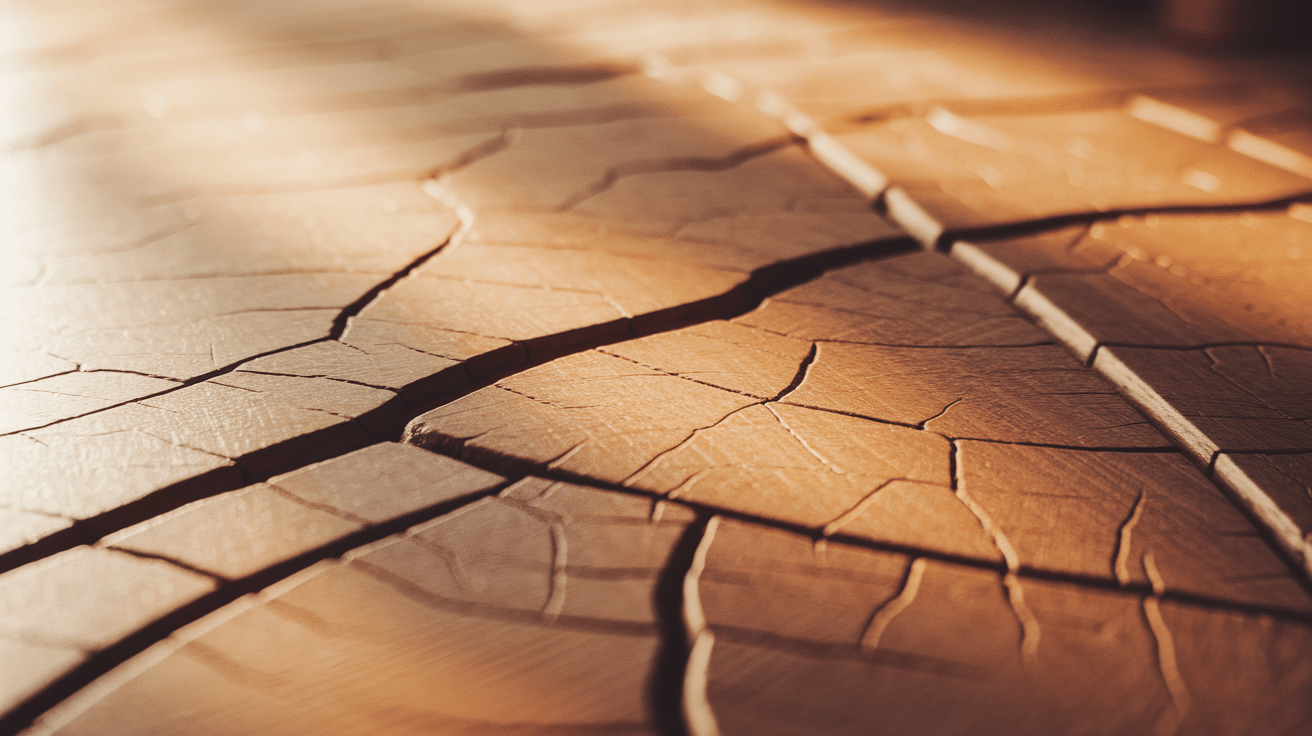
Cracks happen when heavy items drop on floors or when materials contract and expand with temperature changes.
These openings not only look bad but can become safety hazards as they trap dirt and possibly grow larger with continued foot traffic.
How to Fix:
- For tile floors:
- Remove damaged pieces using a chisel and hammer (work slowly from the center out)
- Clean the exposed area thoroughly
- Apply new adhesive with a notched trowel
- Set replacement tile and add spacers
- Once dry, apply and wipe away excess grout
- For wood floors:
- Clean out the crack completely
- Fill with wood filler matching your floor color
- Let dry completely according to product instructions
- Sand smooth with fine-grit sandpaper
- Apply stain if needed to match the surrounding wood
3. Water Damage
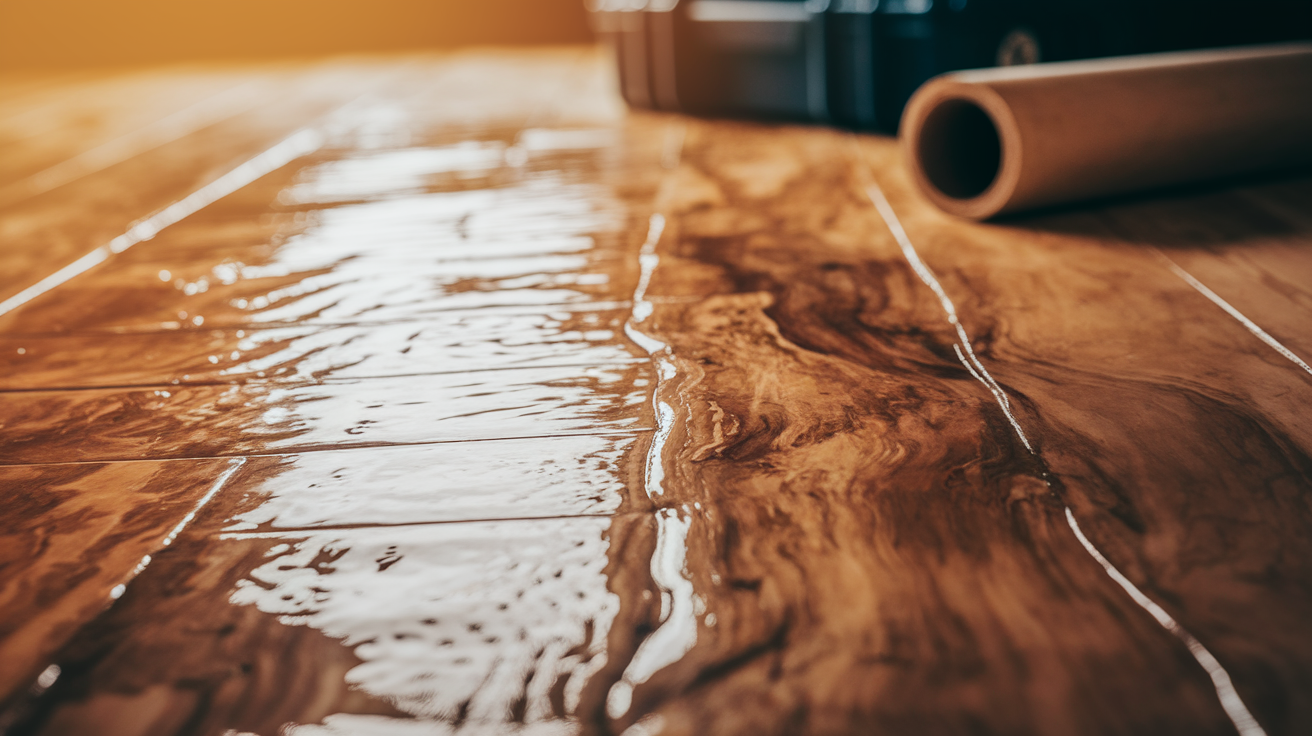
Water seeps into flooring materials, causing swelling and shape changes. If not addressed quickly, it can damage subfloors and create mold problems.
How to Fix:
- Dry area with towels and fans immediately
- Remove damaged sections of the flooring
- Ensure subfloor is completely dry (use fans for 24-72 hours)
- Install matching replacement materials
- Finish to match the existing floor
4. Warping and Bending
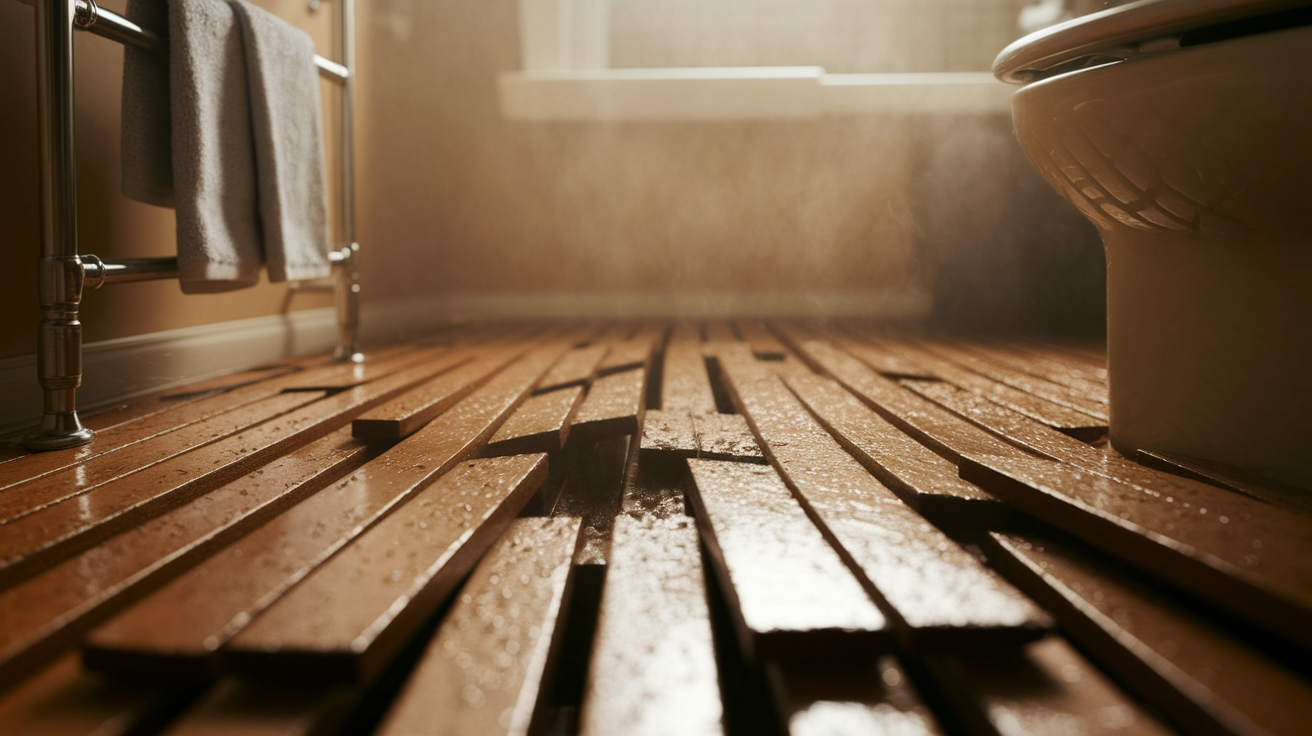
Floors bend when exposed to moisture or humidity changes. This issue is most common with wood and laminate floors in bathrooms, kitchens, and basements.
How to Fix:
- For minor warping:
- Use weights to flatten the area over several days
- Secure with nails or screws once flat
- For severe cases:
- Remove affected planks or sections
- Check the subfloor for moisture issues
- Install new materials after fixing underlying problems
- Consider moisture barriers for future protection
5. Stains and Fading
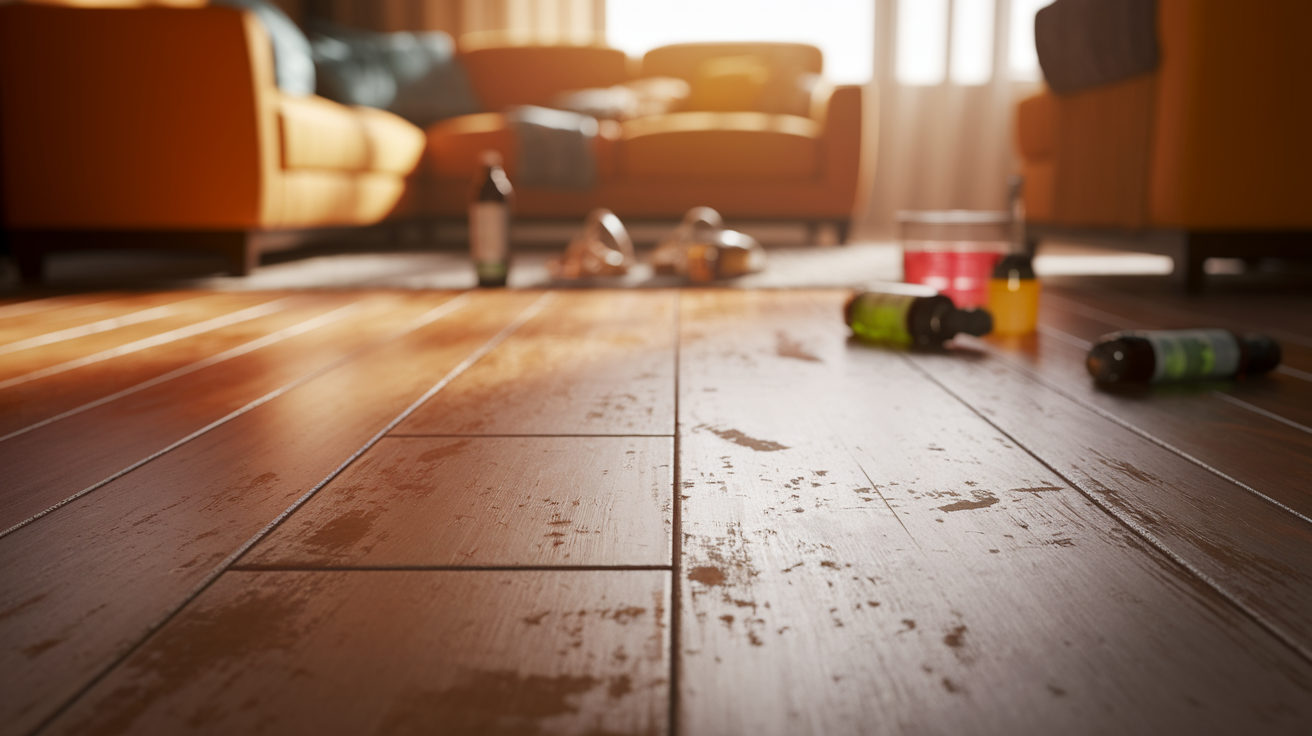
Spills, sunlight, and cleaning products can permanently change floor colors. Different flooring types require specific cleaning methods to avoid worsening the problem.
How to Fix:
- For wood floors:
- Sand lightly to remove surface stains
- Apply a matching stain to blend areas
- Finish with the appropriate sealer
- For carpet:
- Try specialized cleaners for specific stains
- Use baking soda and vinegar for organic stains
- Consider professional cleaning for stubborn marks
- For vinyl and laminate:
- Use manufacturer-approved cleaners only
- For permanent stains, replace damaged sections
6. Loose or Missing Tiles
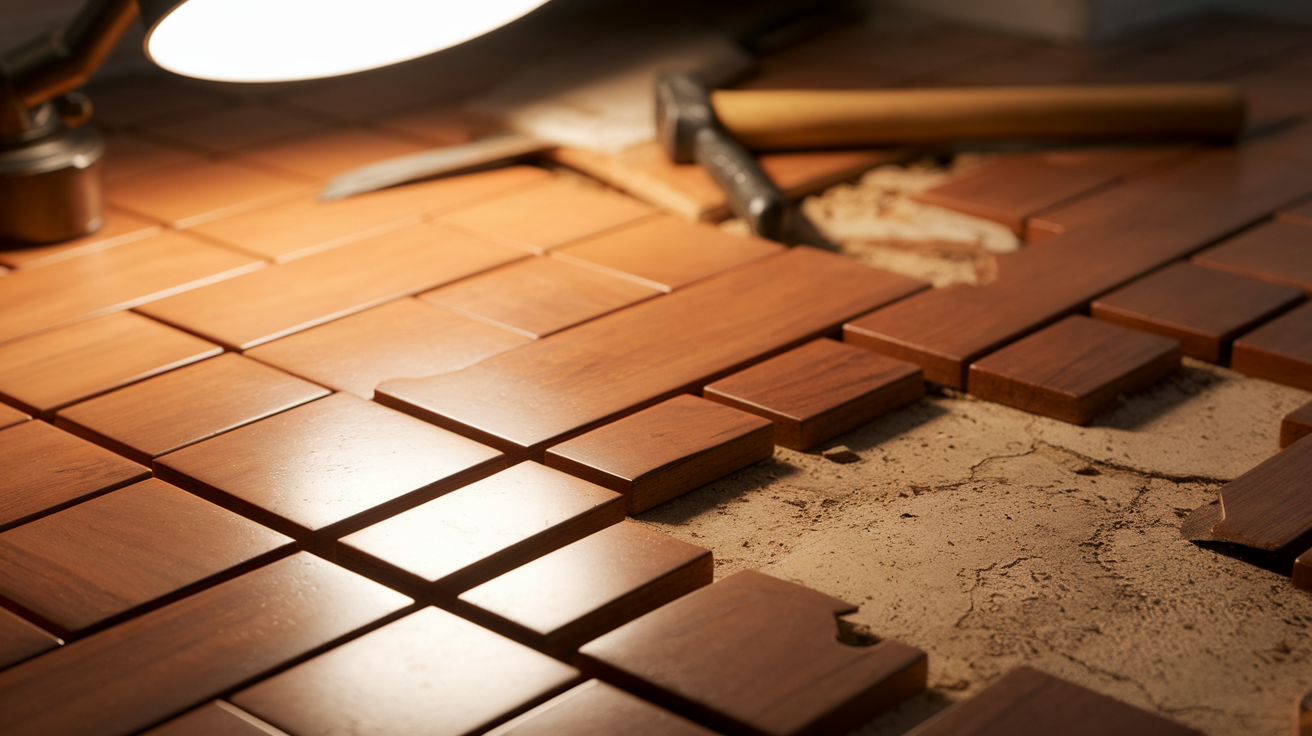
Floor tiles can come loose or fall off due to poor installation, moisture issues, or subfloor movement. This creates both visual problems and safety hazards while allowing water to seep underneath.
How to Fix:
- Clean the back of the loose tile and the floor area thoroughly
- Apply fresh tile adhesive with a notched trowel
- Press the tile firmly into position with spacers for even gaps
- Let the adhesive set according to the product instructions
- Apply matching grout between tiles after the adhesive dries
- For missing tiles:
- Find a matching replacement
- Remove old adhesive from the floor space completely
- Set a new tile with proper spacing and let it dry fully
7. Creaking or Noisy Floors
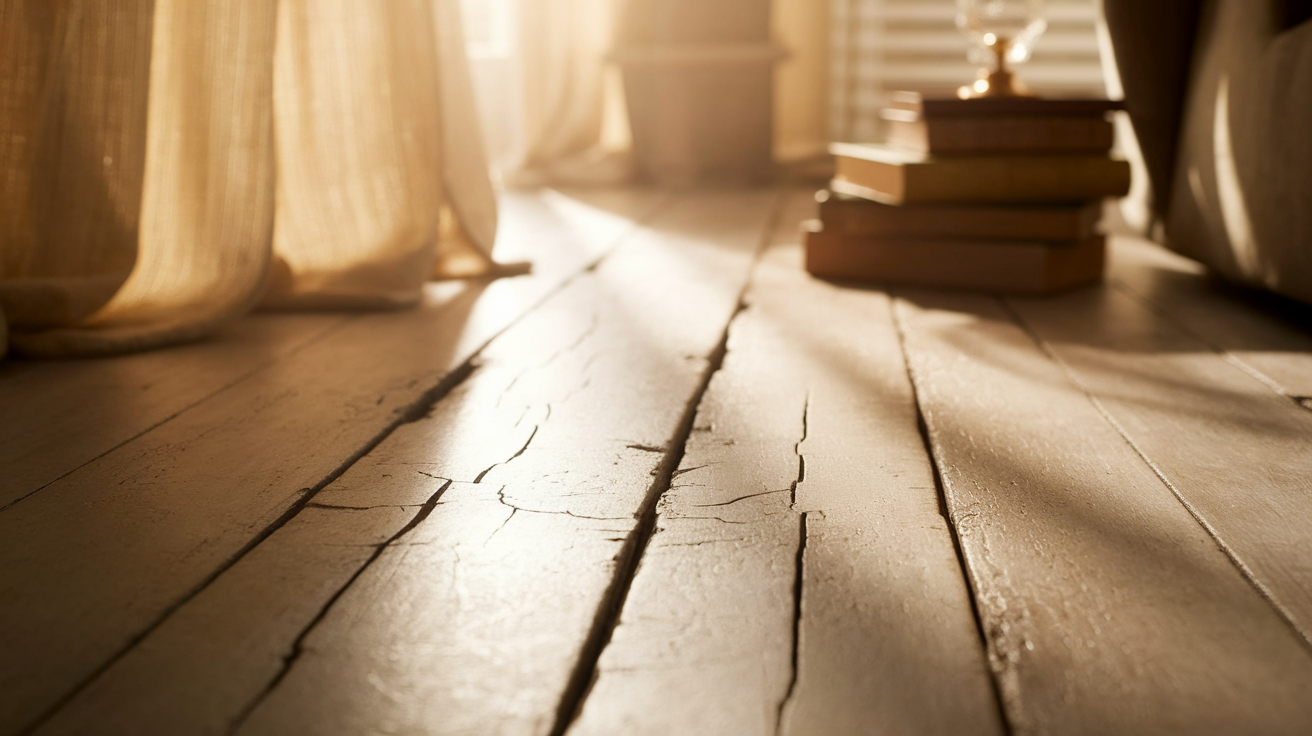
Floor noise typically comes from movement between floor components or against fasteners. It often worsens during dry seasons when wood contracts.
How to Fix:
- Find the exact source of the noise
- Drive trim screws through the subfloor into joists below
- For access from below, insert wood shims between the joists and the subfloor
- Apply powdered graphite or floor lubricant into joints
- For laminate floors:
- Check for uneven subfloor
- Add thin shims to level low spots
- Ensure proper expansion gaps exist around the room edges
- Apply talcum powder between the boards to reduce friction
Cost of Floor Damage Repair
Floor repair costs vary depending on the material type, the extent of the damage, and the complexity. Most homeowners spend between $75 to $300 for DIY repairs or $200 to $500 for professional services.
| Floor Type | Cost Range (per sq ft) | Common Repairs | DIY Possible? |
|---|---|---|---|
| Hardwood | $3-$20 | Scratches, water damage, gaps | Yes, for minor issues |
| Tile | $5-$20 | Cracks, chips, and grout repair | Yes, for small areas |
| Carpet | $1-$3 | Stains, burns, stretching | Sometimes |
| Laminate | $3-$11 | Water damage, chips, and lifting | Yes, for small sections |
| Vinyl | $0.50-$11 | Tears, discoloration, and bubbling | Yes, for minor damage |
| Stone/Marble | $2-$20 | Chips, cracks, dulling | No, needs a specialist |
Additional cost factors:
- Your location (labor rates vary by region)
- Repair complexity (surface vs. structural issues)
- Access difficulty (open room vs. tight spaces)
- Underlying subfloor damage (adds $2-$10 per sq ft)
Prevention Tips for Future Floor Damage
Taking simple steps to protect your floors saves money and extends their life. These practical measures help you avoid common problems before they start.
- Furniture protectors – Place felt pads under all furniture legs to prevent scratches when moved; replace pads every few months as they wear down.
- Strategic rug placement – Use area rugs in high-traffic zones, entryways, and under dining tables with non-slip pads underneath
- Regular cleaning routine – Sweep or vacuum floors twice weekly to remove dirt and small particles that can scratch surfaces
- Quick spill response – Wipe up any liquid spills immediately to prevent water from seeping into seams and causing damage.
- Proper humidity control – Maintain indoor humidity between 30-50% to prevent wood floors from drying out or absorbing excess moisture.
- No shoes indoors – Keep out dirt, small rocks, and outdoor debris by establishing a shoe-free policy with a designated area for footwear
- Pet nail maintenance – Trim pet nails regularly and consider soft nail caps for cats to minimize scratches
Conclusion
Floor damage doesn’t have to be a headache. With the right knowledge and tools, minor issues can be fixed quickly, saving you money and time.
From scratches to water damage, the solutions we’ve discussed can help you extend the life of your flooring. Regular maintenance, early repairs, and preventive measures will also keep your floors looking great for years to come.
If the damage is too extensive or complex, don’t hesitate to call a professional. Now, take a closer look at your floors and start tackling those repairs; you’ll be amazed at the difference they can make!
Ready to take action? Start fixing your floors today and keep your home safe, stylish, and damage-free!
Looking for more ideas? Check out our other DIY Project guides to create a space that’s uniquely yours.

